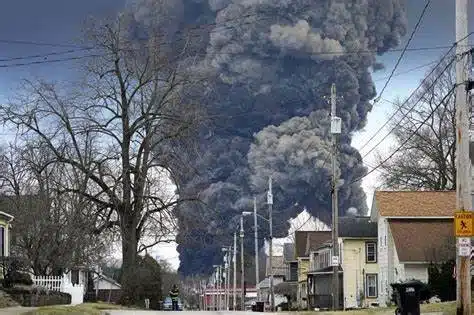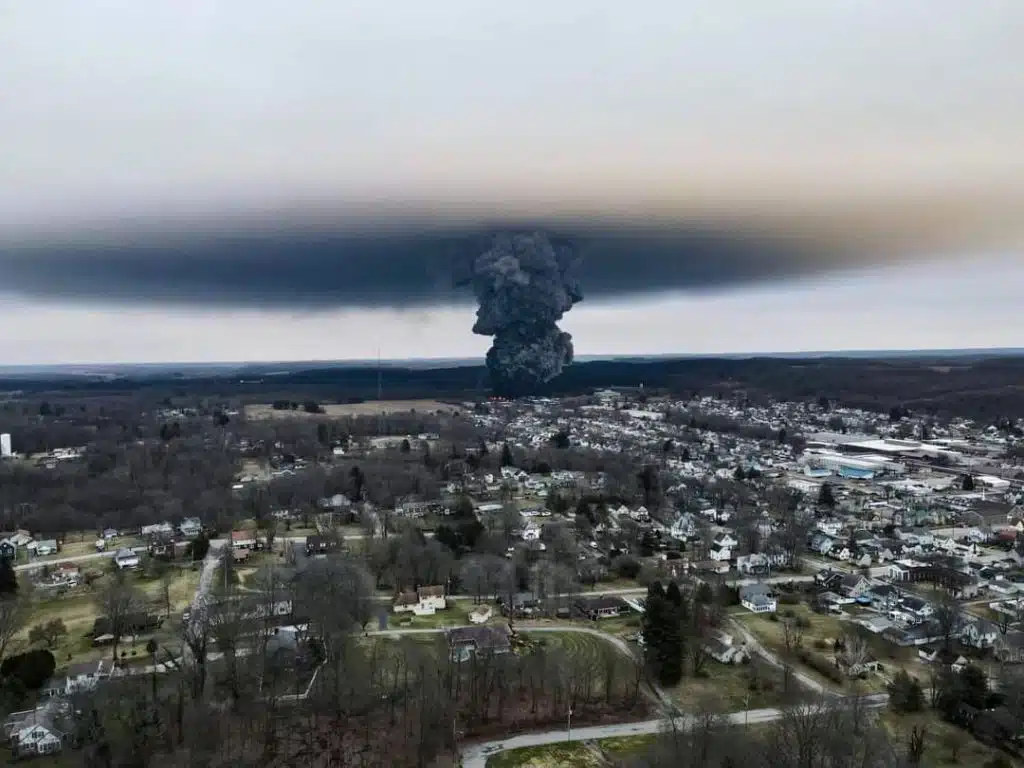Worse than many thought
When we first reported the story of the East Palestine train derailment and subsequent slow burn, we had misinformation. Reports indicated that the chemical released was PVC. It wasn’t. It was VC or Vinyl Chloride, a far more dangerous chemical. We have since updated the information. There were other toxic chemicals as well, including butyl acrylate. The list of chemicals in the affected cars can be found here. The list comes from the railroad.
The slow burn to avoid an explosion was deemed a success. Some residents disagree, and it seems much worse than many thought.
On Feb. 3, about 50 cars of a Norfolk Southern train went off track in Ohio, causing a days-long fire in the area. Ten of the 50 derailed cars contained hazardous chemicals, including butyl acrylate and vinyl chloride, a carcinogen, among combustible liquids that authorities feared could set off a major explosion.
The potential chemical threat:
Probably the best video about what happened in Pennsylvania/Ohio and it’s pretty mind blowing. pic.twitter.com/VbG0kzplRs
— Erin Elizabeth Health Nut News 🙌 (@unhealthytruth) February 13, 2023
Lawsuits filed
After a six-day evacuation, residents returned but now complain of a burning sensation in their eyes, animals falling ill, and a strong odor lingering in the town.
Some business owners and East Palestine residents have filed lawsuits against Norfolk Southern, saying the company was negligent and demanding the company fund court-supervised medical screenings for serious illnesses that may be caused by exposure to those chemicals.
The EPA has found the air and water quality acceptable. But they are the government, and they aren’t here to help.
In addition to vinyl chloride and butyl acrylate, ethylhexyl acrylate is present. It can cause headaches, nausea, and respiratory problems in people exposed to it. Isobutylene, also present, can make people dizzy and drowsy.
The EPA has been monitoring for several other hazardous chemicals, including phosgene and hydrogen chloride. Burning vinyl chloride releaes those chemicals.
Anyone experiencing eye, skin, nose, or throat irritations should contact their doctor. People are recommended to keep surfaces clean and vacuum carefully.
More details:
BREAKING: The @EPA release the legal notice letter sent to @nscorp detailing the extent of the disaster, with many details not previously disclosed concerning the #EastPalestine #chemicalspill pic.twitter.com/NhAHHWdxqD
— Nick D (@nickdrom) February 11, 2023
Not everyone is optimistic.
Thirty million people, or 10% of the United States population, could be in danger. [However, if it exploded, it would have been worse.]
Sil Caggiano is a former battalion chief with the Youngstown Fire Department and a hazardous materials expert. He was critical of the response.
“We basically nuked a town with chemicals so we could get a railroad open,” he told WKBN, a local TV news affiliate.
“We basically nuked a town with chemicals so we could get a railroad open“. Thank you to the expert who appeared on local television who specifically wanted him as he’s on the scene. It’s bad. I wanted the shorter clip for you pic.twitter.com/ZYdogqw2xj
— Erin Elizabeth Health Nut News 🙌 (@unhealthytruth) February 14, 2023
— UAE Exotic Falconry & Finance (@FalconryFinance) February 14, 2023
Ryan in Pittsburgh is taping the potential plume as it travels across the skies.
I hate that they made this real. I hate it so fucking much. Fuck Norfolk Southern. pic.twitter.com/TIURbC5Sz6
— IMC’s Prime Minister (@real91toph) February 13, 2023
Dark skies over Pittsburgh this morning despite the weather report #OhioTrainDisaster #EastPalestine @FalconryFinance pic.twitter.com/tnV4jkH01F
— Ryan (@stringer5189) February 13, 2023
#Pittsburgh #OhioChernobyl #OhioTrainDisaster #EastPalestineOH pic.twitter.com/aWIvXehiro
— Ryan (@stringer5189) February 13, 2023






The Derailment is in Trump country, Democrats don’t care if they are gassed!